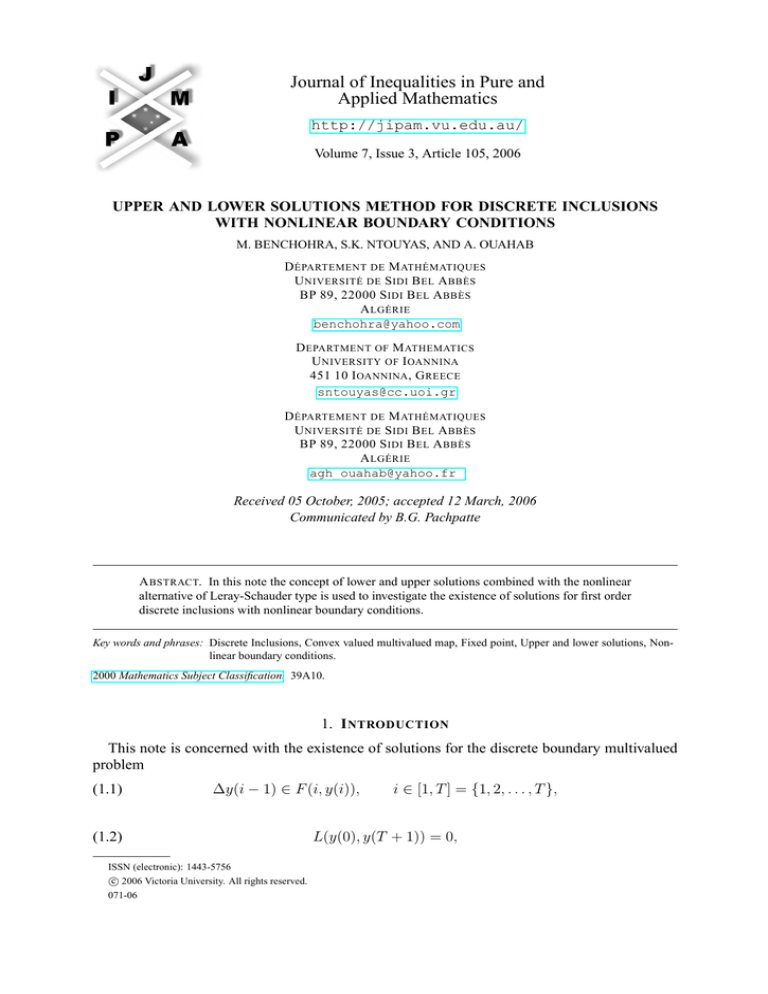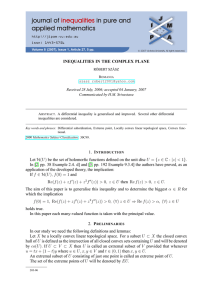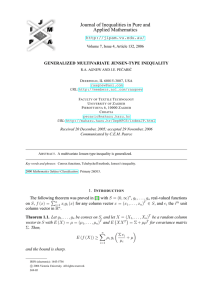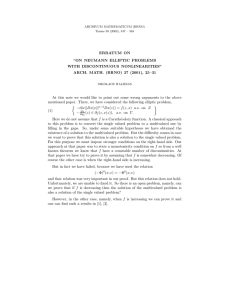
Journal of Inequalities in Pure and
Applied Mathematics
http://jipam.vu.edu.au/
Volume 7, Issue 3, Article 105, 2006
UPPER AND LOWER SOLUTIONS METHOD FOR DISCRETE INCLUSIONS
WITH NONLINEAR BOUNDARY CONDITIONS
M. BENCHOHRA, S.K. NTOUYAS, AND A. OUAHAB
D ÉPARTEMENT DE M ATHÉMATIQUES
U NIVERSITÉ DE S IDI B EL A BBÈS
BP 89, 22000 S IDI B EL A BBÈS
A LGÉRIE
benchohra@yahoo.com
D EPARTMENT OF M ATHEMATICS
U NIVERSITY OF I OANNINA
451 10 I OANNINA , G REECE
sntouyas@cc.uoi.gr
D ÉPARTEMENT DE M ATHÉMATIQUES
U NIVERSITÉ DE S IDI B EL A BBÈS
BP 89, 22000 S IDI B EL A BBÈS
A LGÉRIE
agh_ouahab@yahoo.fr
Received 05 October, 2005; accepted 12 March, 2006
Communicated by B.G. Pachpatte
A BSTRACT. In this note the concept of lower and upper solutions combined with the nonlinear
alternative of Leray-Schauder type is used to investigate the existence of solutions for first order
discrete inclusions with nonlinear boundary conditions.
Key words and phrases: Discrete Inclusions, Convex valued multivalued map, Fixed point, Upper and lower solutions, Nonlinear boundary conditions.
2000 Mathematics Subject Classification. 39A10.
1. I NTRODUCTION
This note is concerned with the existence of solutions for the discrete boundary multivalued
problem
(1.1)
∆y(i − 1) ∈ F (i, y(i)),
(1.2)
ISSN (electronic): 1443-5756
c 2006 Victoria University. All rights reserved.
071-06
i ∈ [1, T ] = {1, 2, . . . , T },
L(y(0), y(T + 1)) = 0,
2
M. B ENCHOHRA , S.K. N TOUYAS ,
AND
A. O UAHAB
where F : N × R −→ P(R) is a compact convex valued multivalued map and L : N2 → R is a
nonlinear single-valued map.
Very recently Agarwal et al [3] applied the concept of upper and lower solutions combined
with the Leray-Schauder nonlinear alternative to a class of second order discrete inclusions subjected to Dirichlet conditions. For more details on recent results and applications of difference
equations we recommend for instance the monographs by Agarwal et al [1], [2], Pachpatte [9]
and the references cited therein.
In this note we shall apply the same tool as in [3] to first order discrete inclusions with
nonlinear boundary conditions which include the initial, terminal and periodic conditions. The
corresponding problem for differential inclusions was studied by Benchohra and Ntouyas in [4].
2. P RELIMINARIES
In this section, we introduce notation, definitions, and preliminary facts which are used
throughout the note. C([0, T ], R) is the Banach space of all continuous functions from [0, T ]
(discrete topology) into R with the norm kyk = supk∈[0,T ] |y(k)|. Let (X, |·|) be a Banach space.
A multivalued map G : X −→ P(X) has convex (closed) values if G(x) is convex (closed) for
all x ∈ X. G is bounded on bounded sets if G(B) is bounded in X for each bounded set B of
X (i.e. supx∈B {sup{|y| : y ∈ G(x)}} < ∞).
G is called upper semicontinuous (u.s.c.) on X if for each x0 ∈ X the set G(x0 ) is a
nonempty, closed subset of X, and if for each open set N of X containing G(x0 ), there exists
an open neighbourhood M of x0 such that G(M ) ⊆ N. G is said to be completely continuous
if G(B) is relatively compact for every bounded subset B ⊆ X.
If the multivalued G is completely continuous with nonempty compact values, then G is u.s.c.
if and only if G has a closed graph (i.e. xn −→ x∗ , yn −→ y∗ , yn ∈ G(xn ) imply y∗ ∈ G(x∗ )).
G has a fixed point if there is x ∈ X such that x ∈ G(x).
For more details on multivalued maps see the books of Deimling [5] and Hu and Papageorgiou [7].
Let us start by defining what we mean by a solution of problem (1.1) – (1.2).
Definition 2.1. A function y ∈ C([0, T ], R), is said to be a solution of (1.1) – (1.2) if y satisfies
the inclusion ∆y(i − 1) ∈ F (i, y(i)) on {1, . . . , T } and the condition L(y(0), y(T + 1)) = 0.
For any y ∈ C([0, T ], R) we define the set
SF,y = {v ∈ C([0, T ], R) : v(i) ∈ F (i, y(i)) for i ∈ {1, . . . , T }}.
Definition 2.2. A function α ∈ C([0, T + 1], R) is said to be a lower solution of (1.1) – (1.2) if
for each i ∈ [0, T +1] there exists v1 (i) ∈ F (i, α(i)) with ∆α(i−1) ≤ v1 (i) and L(α(0), α(T +
1)) ≤ 0.
Similarly a function β ∈ C([0, T + 1], R) is said to be an upper solution of (1.1) – (1.2) if for
each i ∈ [0, T + 1] there exists v2 (i) ∈ F (i, β(i)) with ∆β(i − 1) ≥ v2 (i) and L(β(0), β(T +
1)) ≥ 0.
Our existence result in the next section relies on the following fixed point principle.
Lemma 2.1 (Nonlinear Alternative [6]). Let X be a Banach space with C ⊂ X convex. Assume
U is an open subset of C with 0 ∈ U and G : U → P(C) is a compact multivalued map, u.s.c.
with convex closed values. Then either,
(i) G has a fixed point in U ; or
(ii) there is a point u ∈ ∂U and λ ∈ (0, 1) with u ∈ λG(u).
J. Inequal. Pure and Appl. Math., 7(3) Art. 105, 2006
http://jipam.vu.edu.au/
U PPER
AND
L OWER S OLUTIONS FOR D ISCRETE I NCLUSIONS
3
3. M AIN R ESULT
We are now in a position to state and prove our existence result for the problem (1.1) – (1.2).
We first list the following hypotheses:
(H1) y 7−→ F (i, y) is upper semicontinuous for all i ∈ [1, T ];
(H2) for each q > 0, there exists φq ∈ C([1, T ], R+ ) such that
kF (i, y)k = sup{|v| : v ∈ F (i, y)} ≤ φq (i) for all |y| ≤ q and i ∈ [1, T ];
(H3) there exist α and β ∈ C([0, T + 1], R), lower and upper solutions for the problem (1.1)
– (1.2) such that α ≤ β;
(H4) L is a continuous single-valued map in (x, y) ∈ [α(0), β(0)] × [α(T + 1), β(T + 1)] and
nonincreasing in y ∈ [α(T + 1), β(T + 1)].
Theorem 3.1. Assume that hypotheses (H1) – (H4) hold. Then the problem (1.1) – (1.2) has at
least one solution y such that
α(i) ≤ y(i) ≤ β(i) for all i ∈ [1, T ].
Proof. Transform the problem (1.1) – (1.2) into a fixed point problem. Consider the following
modified problem
(3.1)
∆y(i − 1) + y(i) ∈ F1 (i, y(i)), on [1, T ]
(3.2)
y(0) = τ (0, y(0) − L(y(0), y(T + 1)),
where
F1 (i, y) = F (i, τ (i, y)) + τ (i, y),
τ (i, y) = max(α(i), min(y, β(i))
and
y(i) = τ (i, y).
A solution to (3.1) – (3.2) is a fixed point of the operator N : C([1, T ], R) −→ P(C([1, T ], R))
defined by:
(
)
X
X
1
N (y) = h ∈ C([1, T ]) : h(k) = y(0) +
[g(l) + y(l)] −
y(l), g ∈ S̃F,y
,
0<l<k
0<l<k
where
1
1
= {v ∈ SF,y
: v(i) ≥ v1 (i) a.e. on A1 and v(i) ≤ v2 (i) on A2 },
S̃F,y
1
SF,y
= {v ∈ C([1, T ]) : v(i) ∈ F (i, (y)(i)) for i ∈ [1, T ]},
A1 = {i ∈ [1, T ] : y(i) < α(i) ≤ β(i)}, A2 = {i ∈ [1, T ] : α(i) ≤ β(i) < y(i)}.
Remark 3.2. Notice that F1 is an upper semicontinuous multivalued map with compact convex
values, and there exists φ ∈ C([1, T ], R+ ) such that
!
kF1 (i, y)k ≤ φ(i) + max
sup |α(i)|, sup |β(i)| .
i∈[1,T ]
J. Inequal. Pure and Appl. Math., 7(3) Art. 105, 2006
i∈[1,T ]
http://jipam.vu.edu.au/
4
M. B ENCHOHRA , S.K. N TOUYAS ,
AND
A. O UAHAB
We shall show that N satisfies the assumptions of Lemma 2.1. The proof will be given in
several steps.
Step 1: N (y) is convex for each y ∈ C([1, T ], R).
1
Indeed, if h1 , h2 belong to N (y), then there exist g1 , g2 ∈ S̃F,y
such that for each k ∈ [1, T ]
we have
X
X
hi (k) = y(0) +
[gi (l) + y(l)] −
y(l), i = 1, 2.
0<l<k
0<l<k
Let 0 ≤ d ≤ 1. Then for each k ∈ [1, T ] we have
X
X
(dh1 + (1 − d)h2 )(k) = y(0) +
[dg1 (l) + (1 − d)g2 (l) + y(l)] −
y(l).
0<l<k
0<l<k
Since S̃F1 1 ,y is convex (because F1 has convex values) then
dh1 + (1 − d)h2 ∈ N (y).
Step 2: N maps bounded sets into bounded sets in C([1, T ], R).
Indeed, it is enough to show that for each q > 0 there exists a positive constant `∗ such that
for each y ∈ Bq = {y ∈ C([1, T ], R) : kyk∞ ≤ q} one has kN (y)k∞ ≤ `∗ .
1
Let y ∈ Bq and h ∈ N (y) then there exists g ∈ S̃F,y
such that for each k ∈ [1, T ] we have
X
X
h(k) = y(0) +
[g(l) + y(l)] −
y(l).
0<l<k
0<l<k
By (H2) we have for each i ∈ [1, T ]
|h(k)| ≤ |y(0)| +
k
X
l=1
|g(l)| +
k
X
k
X
|ȳ(l)| +
l=1
|y(l)|
l=1
≤ max(|α(0)|, |β(0)|) + kkφq k∞
!
+ k max q, sup |α(i)|, sup |β(i)|
i∈[1,T ]
+ kq := `∗ .
i∈[1,T ]
Step 3: N maps bounded set into equicontinuous sets of C([1, T ], R).
Let k1 , k2 ∈ [1, T ], k1 < k2 and Bq be a bounded set of C([1, T ]) as in Step 2. Let y ∈ Bq
1
and h ∈ N (y) then there exists g ∈ S̃F,y
such that for each k ∈ [1, T ] we have
X
X
h(k) = y(0) +
[g(l) + y(l)] −
y(l).
0<l<k
0<l<k
Then
|h(k2 ) − h(k1 )| ≤
X
k1 <l<k2
[|g(l)| + |y(l)|] +
X
|y(l)|.
k1 <l<k2
As k2 −→ k1 the right-hand side of the above inequality tends to zero.
As a consequence of Steps 1 to 3 together with the Arzelá-Ascoli theorem we can conclude
that N : C([1, T ], R) −→ P(C([1, T ], R)) is a completely continuous multivalued map.
Step 4: A priori bounds on solutions exist.
J. Inequal. Pure and Appl. Math., 7(3) Art. 105, 2006
http://jipam.vu.edu.au/
U PPER
AND
L OWER S OLUTIONS FOR D ISCRETE I NCLUSIONS
5
Let y ∈ C([1, T ], R) and y ∈ λN (y) for some λ ∈ (0, 1). Then
!
y(k) = λ y(0) −
X
y(l) +
0<l<k
X
[g(l) + y(l)] .
0<l<k
Hence
|y(k)| ≤ |y(0)| +
k
X
l=1
|g(l)| +
k
X
|ȳ(l)| +
l=1
k
X
|y(l)|
l=1
≤ max(|α(0)|, |β(0)|) + T kφk∞
!
sup |α(i)|, sup |β(i)|
+ T max
i∈[1,T ]
+2
i∈[1,T ]
k
X
|y(l)|.
l=1
Using the Pachpatte inequality (see [9, Theorem 2.5]) we get for each k ∈ [1, T ]
"
#
T Y
l−1
X
|y(k)| ≤ c∗ 1 + 2
2 ,
l=1 s=1
where
!
c∗ = max(|α(0)|, |β(0)|) + T kφk∞ + T max
sup |α(i)|, sup |β(i)| .
i∈[1,T ]
i∈[1,T ]
Thus
kyk∞ ≤ c∗ (1 + T 2T +1 ) := M.
Set
U = {y ∈ C([1, T ], R) : kyk∞ < M + 1}.
As in Step 3 the operator N : U −→ P(C([1, T ], R)) is continuous and completely continuous.
Step 5: N has a closed graph.
Let yn ∈ U −→ y∗ , hn ∈ N (yn ), and hn −→ h∗ . We shall prove that h∗ ∈ N (y∗ ).
1
hn ∈ N (yn ) means that there exists gn ∈ S̃F,y
such that for each t ∈ J
n
X
X
hn (i) = yn (0) +
[gn (l) + y n (l)] −
yn (l).
0<l<i
0<l<i
1
We must prove that there exists g∗ ∈ S̃F,y
such that for each k ∈ [1, T ]
∗
X
X
h∗ (i) = y∗ (0) +
g∗ (l) + y ∗ (l)] −
y∗ (l).
0<l<i
0<l<i
Since yn ∈ U , k ∈ N, then (H2) guarantees (see [2, p. 262]) that there exists a compact set
Ω of C([1, T ], R) with {gn } ∈ Ω. Thus there exists a subsequence {ynm } with ynm → y∗ as
k → ∞ and ynm (i) ∈ F (i, ym (i)) together with the map y → F (i, y) upper semicontinuous for
each i ∈ N. Since τ and y are continuous, we have
!
X
[y n (l) − yn (l)]
hn − yn (0) −
0<l<i
!
X
− h∗ − y∗ (0)
[y ∗ (l) − y∗ (l)] −→ 0, as n → ∞.
0<l<i
J. Inequal. Pure and Appl. Math., 7(3) Art. 105, 2006
∞
http://jipam.vu.edu.au/
6
M. B ENCHOHRA , S.K. N TOUYAS ,
AND
A. O UAHAB
Consider the linear continuous operator (topology on N is the discrete topology)
Γ : C([1, T ], R) −→ C([1, T ], R)
X
g 7−→ (Γg)(i) =
g(l).
0<l<i
Moreover, we have that
!
X
hn (i) − yn (0) −
[y n (l) − yn (l)]
= Γ(gn )(i) ∈ F1 (i, yn (i)).
0<l<i
Since yn −→ y∗ , it that
!
h∗ (i) − y∗ (0) −
X
[y ∗ (l) − y∗ (l)
=
0<l<i
X
g∗ (l)
0<l<i
1
S̃F,y
.
∗
for some g∗ ∈
Lemma 2.1 guarantees that N has a fixed point which is a solution to problem (3.1) – (3.2).
Step 6: The solution y of (3.1) – (3.2) satisfies
α(i) ≤ y(i) ≤ β(i) for all i ∈ J.
Let y be a solution to (3.1) – (3.2). We prove that
y(i) ≤ β(i) for all i ∈ [1, T ].
Assume that y − β attains a positive maximum on [1, T ] at k − 1 ∈ [1, T ] that is,
(y − β)(k) = max{y(k) − β(k) : k ∈ [1, T ]} > 0.
By the definition of τ one has
∆y(k) + y(k) ∈ F (t, β(k)) + β(k).
Thus there exists v(i) ∈ F (k, β(k)), with v(k) ≤ v2 (k) such that
∆y(k − 1) = v(k) + β(k − 1) − y(k),
∆y(k − 1) = v(k) − y(k̄) + β(k)
≤ v2 (k) − (y(k) − β(k̄)) < v2 (k).
Using the fact that β is an upper solution to (1.1) – (1.2) the above inequality yields
β(k) − β(k − 1) ≥ v2 (k)
> y(k) − y(k − 1).
Thus we obtain the contradiction
y(k − 1) − β(k − 1) > y(k) − β(k).
Thus
y(i) ≤ β(i) forall i ∈ [1, T ].
Analogously, we can prove that
y(i) ≥ α(i) for all i ∈ [1, T ].
This shows that the problem (3.1) – (3.2) has a solution in the interval [α, β].
Finally, we prove that every solution of (3.1) – (3.2) is also a solution to (1.1) – (1.2). We
only need to show that
α(0) ≤ y(0) − L(y(0), y(T + 1)) ≤ β(0).
J. Inequal. Pure and Appl. Math., 7(3) Art. 105, 2006
http://jipam.vu.edu.au/
U PPER
AND
L OWER S OLUTIONS FOR D ISCRETE I NCLUSIONS
7
Notice first that we can prove
α(T + 1) ≤ y(T + 1) ≤ β(T + 1).
Suppose now that y(0) − L(y(0), y(T + 1)) < α(0). Then y(0) = α(0) and
y(0) − L(α(0), y(T )) ≤ α(0).
Since L is nonincreasing in y, we have
α(0) ≤ α(0) − L(α(0), α(T + 1)) ≤ α(0) − L(α(0), y(T + 1)) < α(0),
which is a contradiction. Analogously, we can prove that
y(0) − L(y(0), y(T + 1)) ≤ β(0).
Then y is a solution to (1.1) – (1.2).
Remark 3.3. Observe that if L(x, y) = ax − by − c, then Theorem 3.1 gives an existence result
for the problem
∆y(i) ∈ F (i, y(i)),
i ∈ [1, T ] = {1, 2, . . . , T },
ay(0) − by(T ) = c,
with a, b ≥ 0, a + b > 0, which includes the periodic case (a = b = 1, c = 0) and the initial
and the terminal problem.
R EFERENCES
[1] R.P. AGARWAL, Difference Equations and Inequalities, Marcel Dekker, New York, 1992.
[2] R.P. AGARWAL, D. O’REGAN AND P.J.Y. WONG, Positive Solutions of Differential, Difference
and Integral Equations, Kluwer Academic Publishers, Dordrecht, 1999.
[3] R.P. AGARWAL, D. O’REGAN AND V. LAKSHMIKANTHAM, Discrete second order inclusions,
J. Difference. Equ. Appl., 9 (2003), 879–885.
[4] M. BENCHOHRA AND S.K. NTOUYAS, The lower and upper solutions method for first order
differential inclusions with nonlinear boundary conditions, J. Inequal. Pure Appl. Math., 3(1) (2002),
Art. 14, 8 pp. [ONLINE http://jipam.vu.edu.au/article.php?sid=166].
[5] K. DEIMLING, Multivalued Differential Equations, De Gruyter, Berlin, 1992.
[6] J. DUGUNDJI AND A. GRANAS, Fixed Point Theory, Mongrafie Mat. PWN, Warsaw, 1982.
[7] Sh. HU AND N. PAPAGEORGIOU, Handbook of Multivalued Analysis, Volume I: Theory, Kluwer
Academic Publishers, Dordrecht, 1997.
[8] B.G. PACHPATTE, Bounds on certain integralinequalities, J. Inequal. Pure Appl. Math., 3(3) (2002),
Art. 47. [ONLINE: http://jipam.vu.edu.au/article.php?sid=199]
[9] B.G. PACHPATTE, Inequalities for Finite Difference Equations, Marcel Dekker, New York, 2002.
J. Inequal. Pure and Appl. Math., 7(3) Art. 105, 2006
http://jipam.vu.edu.au/











